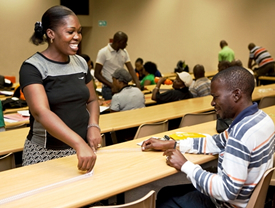| 50% of you think that the South African Government has the potential to make the biggest impact on reducing carbon emissions in South Africa; | |
| 8% opted for the technology sector; and | |
| 42% opted for private industry. |
Shuttle Discovery landed for the last time at Florida’s Kennedy Space Centre on 9 March 2011. Discovery has completed 39 space voyages (its first being on 30 August 1984), has spent a total of 365 days in space and travelled more than 238 million kilometres during it’s lifetime.

 |
Learners take part in experiments at the South African Quantum Physics Camp, during a visit to iThemba LABS in Johannesburg. |
|
 |
Onica Phayane, SAASTA, participates in a physics experiment with an educator at the South African Quantum Physics Camp. |
Physics may seem daunting to some, but last December 100 young “Einsteins” and their educators found out first-hand how much “phun” it can actually be.
One hundred young “Einsteins” and their educators attended the five-day South African Quantum Physics Camp at the Tshwane University of Technology last December. This is the second year that SAASTA was commissioned by the DST to manage the camp, a project aimed at enhancing matric performance in mathematics and physics. The camp’s long-term goal is to increase the number of students that enrol for degrees in science, engineering and technology (SET) at higher education institutions.
Learners and educators took part in “phun” physics lessons, visited local industries and science councils, and received resource material on a variety of subjects such as wavelengths, sound energy, career guides and much more. As 2010 was the International Year of Biodiversity, learners were also treated to a visit to the National Zoological Gardens with talks presented by biodiversity experts from SAIAB and SAEON.
Learners and educators had to write motivations to secure a much sought after place at the camp – learners a one-page essay and educators a one-page letter. The camp is a “phun” and educational event aimed at learners from previously disadvantaged schools who show a keen interest in physics. At the same time it provides educators with the opportunity to learn more about the subject and see its applications in practice.
The project consists of two parts:- Two students and an educator attend a physics camp in Canada.
- One hundred students and 90 educators attend the local camp, which is an extension of the Canadian project.
Participants are involved in the project for two years so that organisers can track their performance over that period.
“We have received very positive feedback on the camps from both the learners and educators. This project is proving to be a valuable tool in exposing young people to physics and in doing so we are laying the groundwork for the next generation of research scientists in South Africa,” says Onica Phayane, SAASTA’s co-ordinator of this project.
